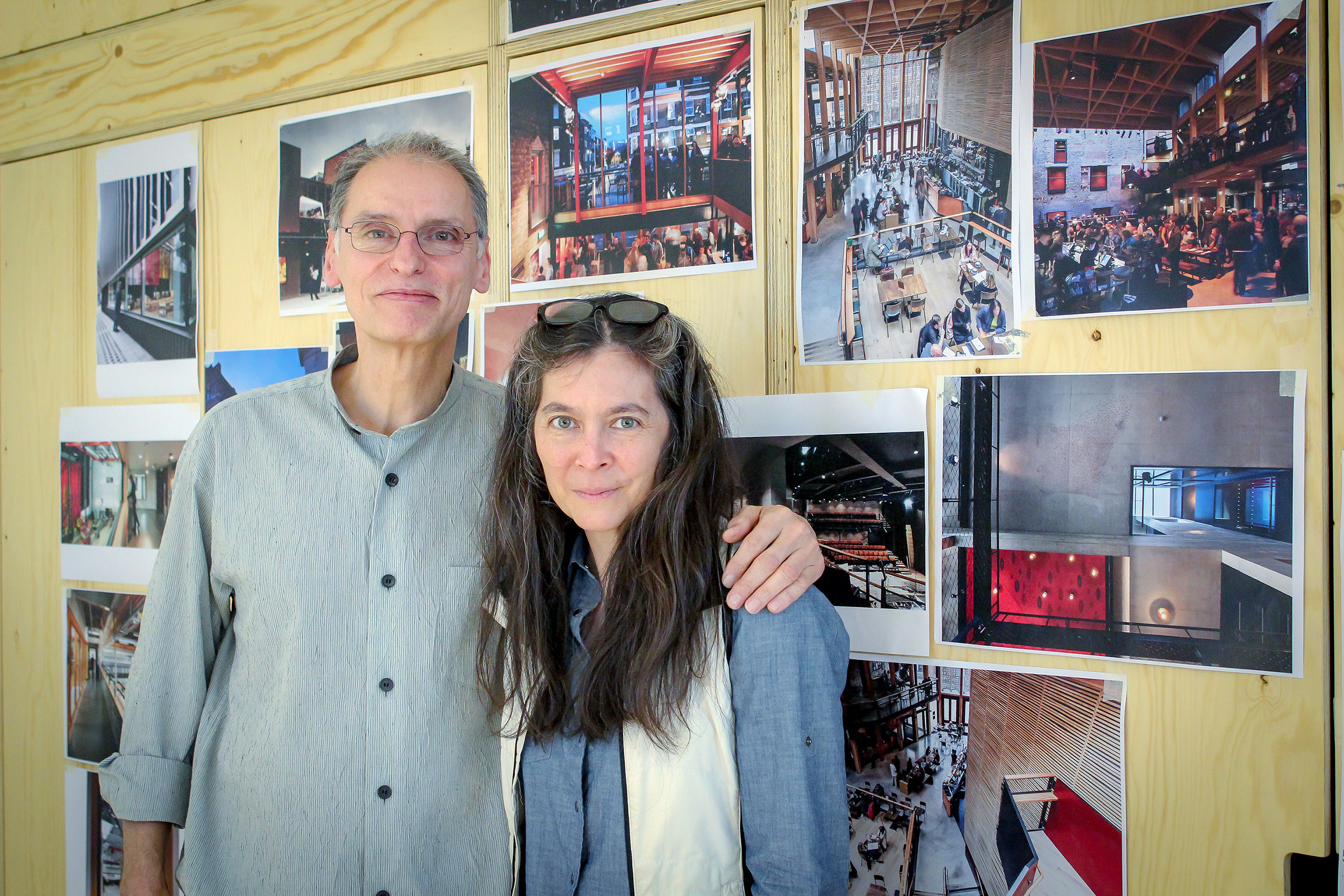
Haworth Tompkins Principal Steve Tompkins and American Repertory Theater Terrie and Bradley Bloom Artistic Director Diane Paulus
Courtesy of the American Repertory Theater
‘A town hall for the 21st century’
Haworth Tompkins selected to design American Repertory Theater’s future home in Allston
American Repertory Theater (A.R.T.) at Harvard University, under the leadership of Terrie and Bradley Bloom Artistic Director Diane Paulus and executive producer Diane Borger, announced today it has selected internationally renowned architects Haworth Tompkins to design its future home on the Allston campus. The forthcoming center for research and performance will be the first U.S. building designed by the U.K.-based firm, which won the Royal Institute of British Architects 2014 Stirling Prize for its design of Everyman Theatre in Liverpool, England. Haworth Tompkins will lead a team that also includes the theatrical consultancy firm Charcoalblue, which has more than 75 studios worldwide, and Boston-based ARC/Architectural Resources Cambridge.
“Haworth Tompkins’ reputation precedes it as one of the great architectural studios of our time,” Paulus said. “Their work — including the Young Vic in London and the recent transformation of the Battersea Arts Centre — reflects the dynamic, transformational energy that is at the core of any theatrical event. Drawing on its experience in sustainable design and urban development, Haworth Tompkins also profoundly understands the role that theaters can play within our cities and communities. It is committed to the values that animate our work at A.R.T., and I look forward to working with HT Director Steve Tompkins and the team to create a building that exemplifies our shared vision of the theater as a town hall for the 21st century.”
Founded in 1991 by Tompkins and Graham Haworth, Haworth Tompkins is recognized for creating intelligent, purposeful, and sustainable designs, and has received more than 150 awards for projects across the sectors of urban residential, culture, heritage, and higher education. It is responsible for more than a dozen of the U.K.’s most highly regarded new and renovated theater buildings, beginning in 2000 with a reworking of London’s Royal Court Theatre.
Signature projects include:
- The Young Vic (2006): Haworth Tompkins rebuilt a space that was originally designed to be temporary but that had evolved into the home of a world-famous theatrical powerhouse. Work included an upgraded auditorium for greater theatrical flexibility and a multifunctional bar/foyer space at the building’s heart that serves as a natural extension of the public street, connecting all three auditoria and serving as a public living room for the local community. Each individual component of the reimagined building was expressed as an individual element to create a more informal presence among the mixed scales of the surrounding streetscape. It was shortlisted for the RIBA Stirling Prize and won RIBA’s London Building of the Year award and the Civic Trust Award established in 1959.
- Bridge Theatre (2017): The first wholly new large theater to be added to London’s commercial theater sector in 80 years, the building features a 900-seat adaptable auditorium. It won a RIBA London Award and The Stage’s Theatre Building of the Year Award.
- Battersea Arts Centre (2018): Haworth Tompkins has been working alongside the Battersea Arts Centre team, the local community, and theater artists for more than a decade on a series of ongoing projects that are gradually transforming the 1893 civic building into a center of creative communal activity and an explicit record of the building’s vivid history. It too won The Stage’s Theatre Building of the Year Award as well as a RIBA regional award.
- Liverpool Everyman (2013): Charged with replacing and re-presenting an iconic Liverpool institution at the center of the city’s cultural and political life, Haworth Tompkins encapsulated the original building’s classless democratic values. Key features include a façade of more than 100 life-sized portrait shutters representing ordinary residents, an auditorium constructed of reclaimed bricks from the former building, and an adaptable thrust stage. The first theater to be recognized with Stirling Prize, the Liverpool Everyman also won the Chicago Athenaeum Architecture Award and The Stage’s Theatre Building of the Year Award.
- National Theatre (2015): Charged with the revitalization of one of the world’s most important producing theaters, Haworth Tompkins designed a new production building and an updated auditorium, transforming the NT’s engagement with the adjacent river walk and surrounding neighborhood, regenerating its main entrance and foyers, and activating the surrounding public spaces. It received a RIBA National Award, RICS National Award, Civic Trust Award, and The Stage’s Theatre Building of the Year Award.
“We are delighted to be joining the A.R.T. and Harvard University in imagining the new center for theater research and performance at Allston,” said Tompkins. “Our shared vision for the project is multifaceted; we will aim to create an inspiring environment for making and experiencing theater, an enduring cultural asset for the University, a positive contributor to the richness and diversity of Allston, an exemplar of environmentally responsible design, and a welcoming place of entertainment, reflection, and debate for the whole community.”
In January 2019, Tompkins was named the most influential person in British theater by The Stage, topping a list of 100 producers, artists, and others. Calling him a modern-day successor to Frank Matcham, the renowned Victorian designer responsible for many of London’s most recognizable theaters, The Stage editor Alistair Smith said, “Unlike Matcham, whose theaters divided audiences by class, Tompkins’ approach is all about democratizing theatergoing … he is literally and physically transforming British theater, and his legacy will be experienced by millions of theatergoers for years to come.”
Harvard University announced in February that a transformative gift from David E. Goel ’93 and his wife, Stacey, would make it possible to begin planning for A.R.T.’s new home, which will anchor the University’s arts presence on its developing Allston campus.
The A.R.T., representatives from Harvard University, and a peer architect review panel unanimously selected Haworth Tompkins for this project after reviewing proposals from firms based in the U.S. and U.K. The site for the new building has yet to be announced. Design work on the building is in the early stages, and the A.R.T. will continue to produce work at the Loeb Drama Center for several years while plans develop.






